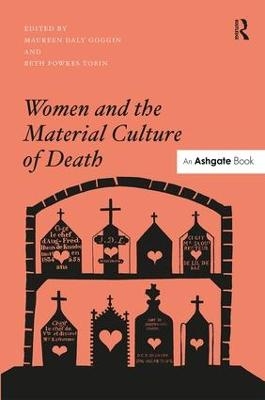
Women and the Material Culture of Death
Routledge (Verlag)
978-1-4094-4416-9 (ISBN)
Examining the compelling and often poignant connection between women and the material culture of death, this collection focuses on the objects women make, the images they keep, the practices they use or are responsible for, and the places they inhabit and construct through ritual and custom. Women’s material practices, ranging from wearing mourning jewelry to dressing the dead, stitching memorial samplers to constructing skull boxes, collecting funeral programs to collecting and studying diseased hearts, making and collecting taxidermies, and making sculptures honoring the death, are explored in this collection as well as women’s affective responses and sentimental labor that mark their expected and unexpected participation in the social practices surrounding death and the dead. The largely invisible work involved in commemorating and constructing narratives and memorials about the dead-from family members and friends to national figures-calls attention to the role women as memory keepers for families, local communities, and the nation. Women have tended to work collaboratively, making, collecting, and sharing objects that conveyed sentiments about the deceased, whether human or animal, as well as the identity of mourners. Death is about loss, and many of the mourning practices that women have traditionally and are currently engaged in are about dealing with private grief and public loss as well as working to mitigate the more general anxiety that death engenders about the impermanence of life.
Maureen Daly Goggin is Professor and Chair in the Department of English, Arizona State University, USA. Beth Fowkes Tobin is Professor of English and Women's Studies at the University of Georgia, USA.
Contents: Connecting women and death: an introduction, Beth Fowkes Tobin and Maureen Daly Goggin; Part I Mourning Practices: Widows and courtesans, ’pizzocchere’ and nuns: women in mourning in the Venetian Republic, 1400-1800, Isabella Campagnol; Fashioning death/gendering sentiment: mourning jewelry in Britain in the 18th-century, Arianne Fennetaux; Emotions and rituals: responses to death among the nobility in modern France, Elizabeth C. Macknight; Stitching (in) death: 18th- and 19th-century American and English mourning samplers, Maureen Daly Goggin; ’The thing they knew’: social exclusion at Southern wakes in Eudora Welty’s The Wanderers and The Optimist's Daughter, Laura Patterson; 'Confessional' poetry and the material culture of death, Gillian D. Steinberg. Part II Memorializing: Columbia mourns: the distaff side of Washington’s long farewell, Meredith Eliassen; More than ’a heap of dust’: the material memorialization of three 19th-century women’s graves, Elizabethada A. Wright; Domesticating death in the sentimental republic: commemorating and mourning in US civil war nurses’ memoirs, Ashley Byock; ’Une fleur que ses yeux éteints ne peuvent plus contempler’: women’s sculpture for the dead, Marjan Sterckx; Spectacle, maintenance, and materiality: women and death in modern Brittany, Maura Coughlin; A conversation with Aunt Carol: the fluid functionality of funeral programs in African-American culture, Michelle J. Pinkard; From private places to public spaces: mourning and death in the art of four 21st-century women, Kathryn Beattie. Part III Bodily Practices: Reading material culture: British women’s position and the death trade in the long 18th century, Michelle Iwen; Hadley chests: a reflection on the chaos and sacrifice of childbirth, B.A. Harrington; ’Feel how soft her hair is’: Amish women’s practices on the female body, Violet A. Dutcher; Representing corporeal ’truth’ in the work of Anna Morandi Manzolini and Mada
| Erscheint lt. Verlag | 8.11.2013 |
|---|---|
| Verlagsort | London |
| Sprache | englisch |
| Maße | 156 x 234 mm |
| Gewicht | 997 g |
| Themenwelt | Geisteswissenschaften ► Psychologie ► Trennung / Trauer |
| Sozialwissenschaften ► Soziologie ► Gender Studies | |
| Sozialwissenschaften ► Soziologie ► Mikrosoziologie | |
| ISBN-10 | 1-4094-4416-3 / 1409444163 |
| ISBN-13 | 978-1-4094-4416-9 / 9781409444169 |
| Zustand | Neuware |
| Haben Sie eine Frage zum Produkt? |
aus dem Bereich


